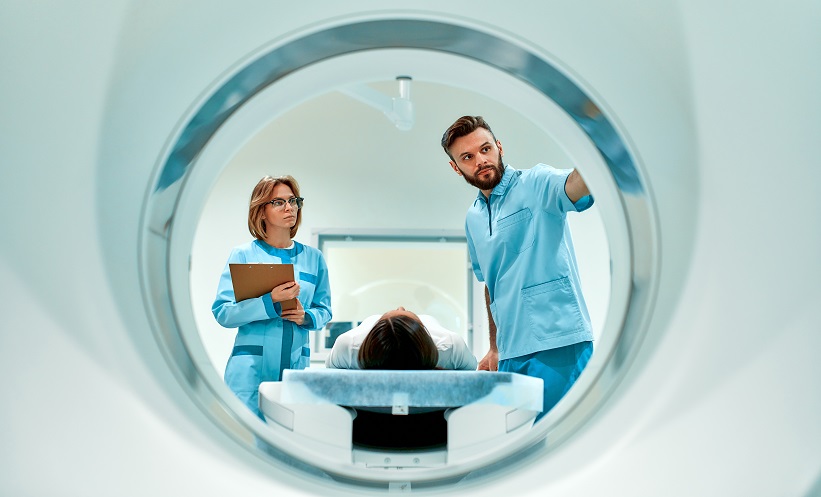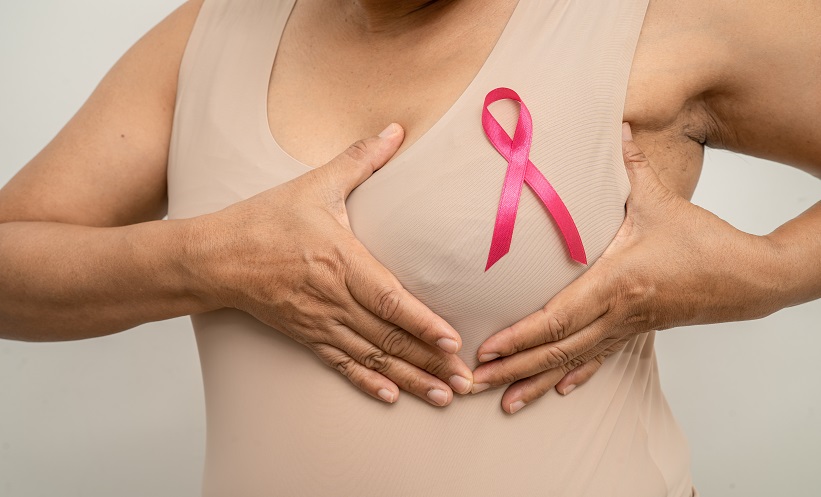‘BUILDING bridges’ was the running theme of the European Congress of Radiology (ECR) 2022. This theme was carried throughout a special range of sessions that focused on the interaction between radiologists and other specialists, but also within radiology, improving practice, patient outcomes, and efficiencies. Building bridges is a fundamental aspect of working towards the future, allowing radiologists to take on a more important role than ever before with clinical workers, policymakers, patients, and industry.
The opening ceremony began with a welcome from the European Society of Radiology (ESR) President, Regina G.H. Beets-Tan, who spoke to attendees located in the audience in Vienna, Austria, but also those attending virtually from around the globe. She emphasised the importance of fortitude, collaboration, and unity from the medical professionals in the wake of ongoing events in Europe, underlining the value and opportunity that congresses such as the ECR provide for this collaboration. Reflecting on the history of radiology as a therapy area, Beets-Tan discussed the growth of the specialty over the last 30 years, filling in the gaps between cutting edge advanced imaging and clinical practice at the time.
New digital technologies, such as artificial intelligence (AI), were emphasised for their ability to shift focus from value-based radiology, perfecting performance and providing opportunities for rapid data sharing across the world. The ECR 2022 featured over 1,000 experts from both within and without the radiology specialty, contributing to the overarching theme of multidisciplinary collaboration and bridge building. Education sessions featuring specialists from over 100 disciplines provided the largest opportunity for peer learning and knowledge sharing. ECR 2022 focused on interactivity, with open forums featuring young radiologists, radiographers, and ESR leaders; and roundtable discussions on pressing issues with leaders and policy makers from the European Union (EU). Patient engagement and patient consideration were highlighted with the ‘Patients in Focus’ programme, and new technology was exhibited in the AI theatre. Beets-Tan further underlined the value of diversity in the congress community, both geographically and professionally. Encouraging different viewpoints, innovation, and building bridges towards the future allows the ESR to advance together with industry partners, international societies, and political networks.
The opening ceremony featured an awards ceremony where extraordinary individuals were praised for their contributions to the field with ESR Honorary Memberships. Firstly, Mary C. Mahoney, Professor of Radiology, University of Cincinnati College of Medicine, Ohio, USA, who has dedicated much of her career to moving breast imaging forward and who contributed to the ECR educational programme, was given an honorary ESR membership. Secondly, Xiao-Yuan Feng, Chairman of the Department of Radiology, Huashan Hospital, Fudan University, Shanghai, China, was recognised for his contributions to global radiological societies and editing positions at radiological journals. Finally, Manuel De Souza Rocha, Associate Professor of Radiology, Universidade de São Paulo, Brazil, was praised for his advocacy of multidisciplinary practice and the exchange of skills, particularly focusing on bowel cancer.
The highest awards given by the ESR, the ESR Gold Medals, were awarded to Laura Oleaga, Head of Imaging CoreLab, Barcelona Clinical Coordinating Centre, MonClinic Foundation, Spain; Bernd Hamm, Head of CharitéCentrum 6, Universitätsmedizin Berlin, Germany; and Luis Martí-Bonmatí, Director of the Medical Imaging Department and Director of Radiology, La Fe University and Polytechnic Hospital, Valencia, Spain. Oleaga’s work in pre- and postgraduate education, commitment to multidisciplinary practice, and position on the ESR education committee working to standardise training for radiology professionals has earned her huge respect within her field, with Beets-Tan describing her as the perfect example of how radiology practice should look in the future. Hamm was praised for his work translating research into clinical practice whilst always considering patient care, and Martí-Bonmatí was commended for his work in technology, the growth of AI, and his leadership in radiological societies.
Beets-Tan closed the opening ceremony by reminding the guests to take advantage of the wide variety of opportunities available to explore over the next 4 days of the congress. She underlined that attendees should “build bridges with colleagues and friends, build bridges with clinical partners and patients, build bridges with societies and international organisations, build bridges with industry partners.” This, she stated, would allow the collective ESR community to move closer to the future of radiology.
Multi-Colour Magnetic Particle Imaging for Detection of Gastrointestinal Haemorrhage
FASCINATING research on imaging techniques for gastrointestinal (GI) haemorrhage was presented at ECR 2022. Taking place from 13th–17th July, researchers from the University Medical Center Hamburg-Eppendorf, Hamburg, Germany, shared insights into their findings of multi-colour magnetic particle imaging (MPI) for real-time detection of the condition.
The occurrence of GI haemorrhage can be life-threatening to patients and requires rapid diagnosis and evaluation. Current methods for diagnosis include invasive endoscopic techniques, which may not enable imaging of the full GI tract, and CT angiography as a method using ionising radiation. As well as being a radiation-free technique, MPI imaging offers the advantage of multi-contrast cross-sectional imaging using superparamagnetic tracers at a high spatiotemporal resolution, enabling radiologists to detect multiple tracers.
Led by Christoph Reidel, Department of Diagnostic and Interventional Radiology and Nuclear Medicine, University Medical Center Hamburg-Eppendorf, the researchers’ hypothesis focused on the use of single- and multi-contrast MPI to enable 3D real-time detection for GI bleeding. An ex vivo study was performed using a bowel phantom consisting of a luminal compartment and a vascular compartment to mimic the lumen and perfused bowel wall, in which blood pool tracers were injected. The researchers also used a ligated porcine small bowel specimen with cannulated mesentery vessels to facilitate intravascular and intraluminal tracer injection. Dynamic imaging was performed using a preclinical MPI.
The results presented showed a clear enhancement of the bowel wall, with no tracer extravasation into the control lumen. In the case of GI bleeding, an extravasation of the blood pool tracer into the lumen was observed, with multi-contrast MPI showing the mixing of tracers and indicating the presence of a GI haemorrhage. Graphical evidence presented by Reidel showed the normalised signal intensity in the bowel and lumen. The GI bleed showed the tracer signal intensity increase in the phantom bowel wall, with the multi-tracer signals intersecting within the phantom lumen. The small bowel specimen showed similar results, with tracer signal intensity mixing with the presence of a GI bleed.
Reidel presented the study conclusions, which indicated that single- and multi-contrast MPI is a feasible technique to visualise real-time 3D bowel wall perfusion, both in the phantom bowel and specimen. He also noted that this may emerge as a radiation-free tool for non-invasive detection of acute and chronic GI haemorrhage.
PTEN Hamartoma Tumour Syndrome: The Role of MRI
PTEN hamartoma tumour syndrome (PHTS) is rare, with one in 200,000 individuals worldwide having pathological PTEN variants. Having a pathological variant of PTEN poses a lifetime breast cancer risk of 85% and has also been associated with higher rates of benign breast disease.
Retrospective study data presented by Alma Hoxhaj, Department of Medical Imaging, Radboud University Medical Center, Nijmegen, the Netherlands, and Department of Radiology, Netherlands Cancer Institute, Amsterdam the Netherlands, at ECR 2022, Vienna, Austria, on 16th July highlighted how MRI features in females with PHTS could assist with early breast cancer diagnosis and reduce the number of biopsies these patients undergo.
The team investigated imaging features of benign and malignant breast lesions in patients with PHTS. They recruited females aged 18 years and over with either a confirmed PTEN pathogenic variant or clear clinical PHTS phenotype, who had been referred to a specific Radbound University Medical Center clinic between 2001 and 2021.
A total of 65 females were included in the study and the corresponding available MRI images were read independently by two radiologists. Of these 65 individuals, 21 patients (32%) had a previous diagnosis of histology-confirmed breast cancer and 23 patients (35%) had histology-confirmed diagnosis of benign breast disease.
Thirty-five breast cancers were identified from the 21 females with previous breast cancer diagnosis. However, MRI data was only available for 14 of these 35 cancers. The following MRI analysis showed that typical breast cancer features were visible in 71% and typical benign or dubious features were seen in the remaining 29%. Of the 23 females with confirmed benign breast disease, 89 different benign breast lesions were identified. However, MRI imaging was only available for 67 lesions. Of these, 82% displayed typical benign features and 18% displayed dubious/malignant features. Those who displayed dubious/malignant features proceeded to biopsy for further clarification.
Although the study was limited by low numbers of PHTS breast cancers with available MRI data, Hoxhaj concluded that MRI should be considered as a tool for early diagnosis of breast cancer in this patient cohort and could also help to reduce the number of biopsies patients with PHTS are subject to. Whilst these findings are promising, further evaluation in larger samples is required to provide consensus.
Ultrasonography Allows Detection of Vascular Complications Following Renal Transplantation
RENAL transplant is the primary treatment option for patients presenting with end-stage renal disease. In fact, not only does transplant provide a better quality of life for the patients, but it is also associated with a longer life expectancy. In this context, Doppler ultrasound is a useful tool employed to evaluate the transplanted kidney, both in the postoperative period and in the long-term follow-up, particularly for the assessment of vascular patency and the detection of complications within the renal vasculature.
At ECR 2022, Teresa Cobo Ruiz, Radiology Resident, Hospital Universitario Marqués de Valdecilla Santander, Spain, shared an insightful presentation on the potential of Doppler ultrasound in detecting vascular complications following renal transplantation. Although rare, vascular complications, which only occur in less than 10% of patients, can result in kidney loss. Therefore, being able to recognise them in a timely manner is essential.
In this review presentation, the author presented the role of ultrasonography in the detection of vascular complications. Firstly, in segmental infarctions, contrast-enhanced ultrasound can be used to confirm the presence of these infarctions. If stenosis in the common or external iliac artery occurs, spectral Doppler ultrasound will display parvus-tardus waveforms in the main and interstitial arteries, elevated velocities at the stenosis, and downstream parvus-tardus waveforms. In renal artery stenosis, spectral Doppler ultrasound displays turbulent flow with aliasing at the stenosis and parvus-tardus waveforms in the renal arteries and renal parenchymal arteries. In renal artery thrombosis, the ultrasound shows absent arterial and venous flow distal to the thrombosed segment of the renal artery. If renal vein thrombosis occurs, Doppler ultrasound displays enlarged kidney with absent or diminished renal flow in the main renal area and complete reversal of diastolic flow in the main renal artery and intrarenal arterial branches. In a pseudoaneurysm, anechoic image with yin–yang flow will be observed in the Doppler ultrasound. Finally, arteriovenous fistulas appear as turbulent flow or colour mosaic beyond the confines of a normal vessel on color Doppler.
This review demonstrated the usefulness and effectiveness of ultrasonography to evaluate anatomical characteristics and vascular Doppler flow in renal transplant. Cobo Ruiz concluded by highlighting that many vascular complications may be potentially treatable if detected early, and the interventional radiologist has an important therapeutic role in these cases.
Dose Exposure in Common Radiological Procedures: The Patient Perspective
RADIOLOGICAL procedures, which are used widely across hospital departments around the globe, expose patients to doses of ionising radiation. Their continued use has led to a rise in the number of patients requiring reliable and adequate information about the risks such procedures can pose.
Both governments and non-governmental bodies, including the European Atomic Energy Community (EURATOM) and the International Atomic Energy Agency (IAEA), have endorsed the right to information for patients. In 2013, a EURATOM directive outlined patient knowledge about radiation doses in particular procedures, and the IAEA has affirmed that professionals must inform patients about both the potential benefits of radiological procedures, and the risks which come with exposure to ionising radiation. Countries including Italy have made it an obligation for medical professionals to give “specific and adequate information to the patient” before such procedures.
In 2013, the ESR launched the ESR Patient Advisory Group (ESR-PAG), in order to bring patients and healthcare professionals together to positively influence advances in medical imaging throughout Europe, and to improve communication between patients and healthcare departments, ultimately improving services.
At ESR 2022, study lead Sergio Salerno, Department of Biomedicine, Neuroscience Advanced Diagnosis (BIND), A.O.U.P. ‘Paolo Giaccone’ University of Palermo, Sicily, Italy, presented the results of a cross-sectional study in collaboration with Radiology departments at A.O.U. ‘Carreggi’ University of Firenze, Italy; Ospedale Pediatrico Bambino Gesù, Rome, Italy; and Istituto ‘Giannina Gaslini’, Genova, Italy. Researchers aimed to investigate patients’ understanding of ionising radiation in radiological procedures, patients’ interest in knowing the dose of radiation they were exposed to, and what the most effective written method would be in conveying dose exposure for different patient groups.
Patients from all four centres were included, provided that they were undergoing planned rather than emergency radiological examinations, and their participation was voluntary. All patients (n=1,009) filled in an anonymous questionnaire. Overall, 68.1% of respondents were female; 7.1% were parents of paediatric patients.
Conclusions reached were that the majority of patients were interested in knowing exposure levels in radiological procedures, and that information presented with corresponding icons provided the most understanding across patient groups (sex, education level, and socioeconomic level). The recommendation of the researchers is that such icons should be improved, in order to ensure an “explanatory semi-quantitative model,” which can be “universally understood.”
The Latest in Artificial Intelligence-Powered, Software-Defined MR Systems and Solutions
THE COVID-19 pandemic has been a catalyst for change and amplified a number of challenges in healthcare. However, one constant throughout this period has been the importance of diagnosis. Despite this, the diagnostic process has never been as complicated as it is today. At ECR 2022, which took place in Vienna, Austria, Kees Wesdorp, Chief Business Leader of Precision Diagnosis at Philips (Eindhoven, the Netherlands), and Arjen Radder, General Manager of Magnetic Resonance (MR) at Philips, discussed why Philips was uniquely positioned to drive meaningful change in this field.
According to the latest Philips Future Health Index report, one of the most substantial challenges facing radiology leaders is managing the vast quantity of data available to them. Indeed, almost one quarter of respondents cited data management as their top issue. Philips offer a suite of artificial intelligence-powered and software-defined systems that can help turn relevant data into actionable insights, leading to increased diagnostic confidence and improved clinical outcomes.
At this year’s ECR, Philips introduced SmartSpeed, their latest artificial intelligence-powered, MR acceleration software, which can deliver higher image resolution with three times faster scanning times. SmartSpeed is also notable for being compatible with 97% of current clinical MR protocols, which enables faster and high-quality scans for individuals with various conditions, including those with implants. The MR 7700 was also shown at ECR 2022 for the first time. This smart, connected imaging system enhances diagnostic confidence and improves efficiency as well as patient and staff experience.
Other new innovations included the software-defined and helium-free MR 5300; the Spectral CT 7500, which is capable of delivering a 34% decrease in overall time to diagnosis; and the Philips Radiology Operations Command Center, which removes communication barriers and connects imaging experts in a command centre with technologists at scan locations across an organisation. Wesdorp shared his belief that these breakthrough solutions will bring Philips one step closer to its goal of improving 2.5 billion lives per year by 2030.








